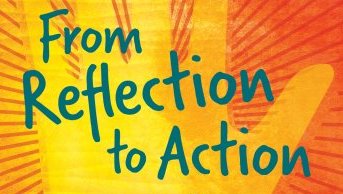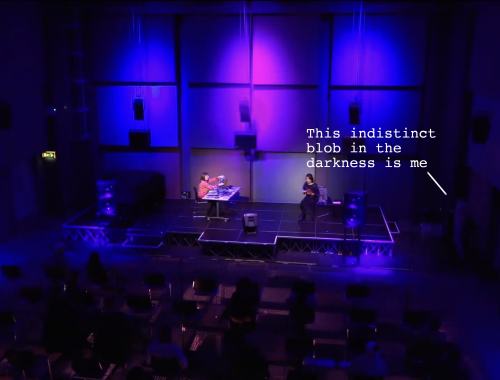
Improvising like jazz
I have always admired jazz musicians; with the way they so effortlessly riff off one another to create a beautiful synergy of sounds. Feeling the flow of the music and improvising as they go is something I respect but in my own artistic work, struggle with accepting.
I am aware that as a creative person you must “go with the flow” and not be so rigid in your approach, but as an inherently anxious person, this idea can stress me out. So, when I took on the role of vision-mixer for livestreaming a jazz concert, I knew I had to face these fears and well – improvise! Therefore, I will be reflecting on this experience using Schön’s model of reflection as his work encourages both reflections immediately during the event to “make on-the-spot adjustments” (Schön 55), as well as reflecting after the event to further improve your craft.

The event – what happened?
Previously, when vision-mixing livestreams, I have been limited to following classical pieces, which had a predictability to them in terms of what shots to use. With the typical four beats to a bar structure, the main musician and accompanying piano it was clear to follow along and piece together an engaging production. However, with multiple jazz musicians riffing off one another, it was unfamiliar territory to what had now become my comfort zone of filming classical musicians. While I was excited for something new, reflecting back I have learnt that a feeling of a lack of control triggers my anxiety, as I strive for perfection in all areas of my life, most importantly in my professional work. The uncertainty and unpredictability of the piece meant that I would have to act quick and there may be a delay in getting the perfect shot. Additionally, I was aware that:
“Live videos hold users’ attention 10-20x longer than pre-recorded, on-demand content.”
(Krings, The top 115 live streaming statistics and Trends for 2022)
The pressure was on.
While the feeling of a lack of control was there, I reminded myself that I was in control as I was directing the team and controlling the livestream. I decided to slow down and breathe as the panic would only lead me to perform poorly, thus I proceeded calmly, reacting to what I heard and showing the audience accordingly. As vision-mixer I must “carry out a socially convincing sense of the real… for which a sense of reality is constructed” (Fiske 21), therefore I would simply show whatever instrument was dominant in the moment. For example, if there was a saxophone solo, I would zoom in on the saxophone.
Everything was going well with this action plan until comms – the means in which I could communicate to my team – went down. I panicked as my team couldn’t get the shots I wanted as they couldn’t hear me, so I missed out on showcasing certain moments from the concert such as solos. Additionally, as comms cut out which camera I wanted to zoom in, multiple cameras assume it was their one I was referring too, even the camera that was live!

As stressful as the situation was, I feel as if I navigated it well and approached my team with humour afterwards when talking about the mistakes we collectively made. This deflated the tension felt whilst simultaneously “increasing solidarity” which is important when approaching “directives and criticism” (Pullin, 266)
After the event – What can I learn from this?
Looking back at the experience, I have discovered that a lack of control is a trigger for my anxiety, which provided a comfort as I am able to recognise this in the future. Therefore, if I am in an environment where I feel helpless, I can recognise the cause and reassure myself that it is mind over matter. While I don’t enjoy this feeling, I understand that practice makes perfect, and the purpose of this placement is to learn new skills and to challenge myself. Thus, as stated by Gregory et al. “It is all about pushing your comfort zone and trying new things.” (63).
Perhaps the reason I was so anxious was because I don’t have a lot of experience in vision-mixing having only done this a few times before, in which I could provide a formulaic approach to familiar pieces. Whereas, to have to react to the changes as I saw them on multiple screens and quickly choose the best and most relevant made me feel well out of my depth and victim to impostor syndrome. Upon reflection I understand that this feeling did not reflect reality as I had earned my spot on the placement and had learnt the necessary skills from my course. However, I now understand that it is my lack of confidence that makes me feel this way and I am entitled to make mistakes as I master this skill, as “adjusting how you think about competence, failure and success the fastest path to overcoming the impostor syndrome” (Young, 7).
Therefore, I have developed the following action plan to assist me when I vision mix in the future:
- If comms goes don’t panic! Have a backup mode of communication in the form of text messages, ensuring everyone has a phone on hand.
- If I feel out of control, remind myself that I literally am the one in control of the livestream and nothing will change unless I do it myself.
- Know that I am entitled to make mistakes in my learning process and don’t have to be an expert straight away, knowing that art can “be learnable” (Schön 18) and that I must practice the skill to refine it.
Overall, by reflecting on this experience, I have learnt a great deal about how my mind operates when under pressure. By focusing “on the outcomes of action, the action itself, and the intuitive knowing implicit in the action.” (Schön 56) when reflecting, the knowledge I have learnt about myself will thus aid me in the future as I will be intuitively aware of my thought process and can remind myself that my feeling doesn’t reflect the reality. Therefore, reflection has enabled me to act as the jazz musicians and improvise, without the stress of being perfect and allow me to enjoy this aspect of the placement. After all, in the immortal words of musician George Gershwin:
“Life is a lot like jazz, it’s better when you improvise!”
References
- Fiske, John. Television Culture. 6th ed., Routledge, 1989.
- Gregory, Georgina, Ros Healy, and Ewa Mazierska. Careers in media and film: the essential guide. Sage, 2008.
- Krings, Emily. “The Top 115 Live Streaming Statistics and Trends for 2022.” Dacast, 2 Mar. 2022, https://www.dacast.com/blog/66-must-know-live-streaming-statistics/?msclkid=34261c76ad4b11ecb2d64b4b8c50c37a.
- Pullin, Patricia. “Humour and Integration of New Staff in the Workplace’.” The Pragmatics of Humour across Discourse Domains (Pragmatics & Beyond New Series), edited by Marta Dynel, John Benjamins Publishing Company, 2011, pp. 265–87.
- Schön, Donald. The Reflective Practitioner: How Professionals Think In Action. 1st ed., Basic Books, 1984.
- Young, Valerie. The secret thoughts of successful women: Why capable people suffer from the impostor syndrome and how to thrive in spite of it. Currency, 2011.
You May Also Like

Reflection-In-Action: The Value of Challenges
25 March 2022
An Experience Never To Forget
1 April 2022

